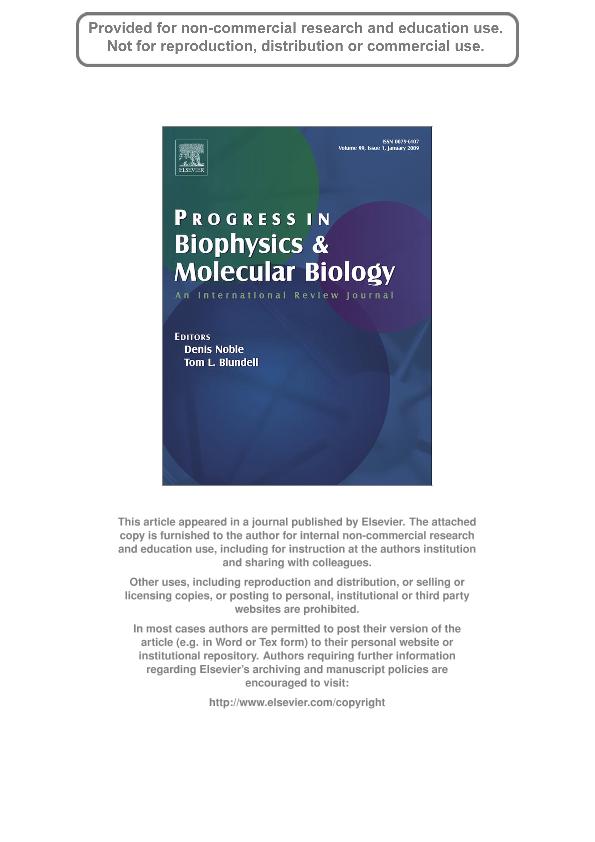Mostrar el registro sencillo del ítem
dc.contributor.author
Caramelo, Julio Javier

dc.contributor.author
Iusem, Norberto Daniel

dc.date.available
2017-10-03T17:00:37Z
dc.date.issued
2008-10
dc.identifier.citation
Caramelo, Julio Javier; Iusem, Norberto Daniel; When cells lose water: Lessons from biophysics and molecular biology; Elsevier; Progress In Biophysics And Molecular Biology; 99; 1; 10-2008; 1-6
dc.identifier.issn
0079-6107
dc.identifier.uri
http://hdl.handle.net/11336/25755
dc.description.abstract
Organisms living in deserts and anhydrobiotic species are useful models for unraveling mechanisms used to overcome water loss. In this context, late embryogenesis abundant (LEA) proteins and sugars have been extensively studied for protection against desiccation stress and desiccation tolerance. This article aims to reappraise the current understanding of these molecules by focusing on converging contributions from biochemistry, molecular biology, and the use of biophysical tools. Such tools have greatly advanced the field by uncovering intriguing aspects of protein 3-D structure, such as folding upon stress. We summarize the current research on cellular responses against water deficit at the molecular level, considering both plausible water loss-sensing mechanisms and genes governing signal transduction pathways. Finally, we propose models that could guide future experimentation, for example, by concentrating on the behavior of selected proteins in living cells.
dc.format
application/pdf
dc.language.iso
eng
dc.publisher
Elsevier

dc.rights
info:eu-repo/semantics/openAccess
dc.rights.uri
https://creativecommons.org/licenses/by-nc-sa/2.5/ar/
dc.subject
Lea Proteins
dc.subject.classification
Otras Ciencias Químicas

dc.subject.classification
Ciencias Químicas

dc.subject.classification
CIENCIAS NATURALES Y EXACTAS

dc.title
When cells lose water: Lessons from biophysics and molecular biology
dc.type
info:eu-repo/semantics/article
dc.type
info:ar-repo/semantics/artículo
dc.type
info:eu-repo/semantics/publishedVersion
dc.date.updated
2017-09-29T16:42:38Z
dc.identifier.eissn
1873-1732
dc.journal.volume
99
dc.journal.number
1
dc.journal.pagination
1-6
dc.journal.pais
Reino Unido

dc.journal.ciudad
Oxford
dc.description.fil
Fil: Caramelo, Julio Javier. Consejo Nacional de Investigaciones Científicas y Técnicas. Oficina de Coordinación Administrativa Parque Centenario. Instituto de Investigaciones Bioquímicas de Buenos Aires. Fundación Instituto Leloir. Instituto de Investigaciones Bioquímicas de Buenos Aires; Argentina. Universidad de Buenos Aires. Facultad de Ciencias Exactas y Naturales. Departamento de Química Biológica; Argentina
dc.description.fil
Fil: Iusem, Norberto Daniel. Consejo Nacional de Investigaciones Científicas y Técnicas. Oficina de Coordinación Administrativa Ciudad Universitaria. Instituto de Fisiología, Biología Molecular y Neurociencias. Universidad de Buenos Aires. Facultad de Ciencias Exactas y Naturales. Instituto de Fisiología, Biología Molecular y Neurociencias; Argentina
dc.journal.title
Progress In Biophysics And Molecular Biology

dc.relation.alternativeid
info:eu-repo/semantics/altIdentifier/url/http://www.sciencedirect.com/science/article/pii/S0079610708000667
dc.relation.alternativeid
info:eu-repo/semantics/altIdentifier/doi/https://doi.org/10.1016/j.pbiomolbio.2008.10.001
Archivos asociados
